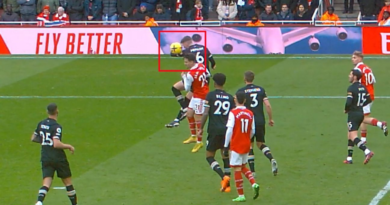USWNT relies on individual players, but lacks team creativity or tactical identity
PHEEEEEEEEEEWWWWW.
It was anxiety-inducing enough for the U.S. women’s national team to carry three losses in a row heading into Sunday’s friendly vs. Germany, but no one — NO ONE — wants to go into the history books as being that team to lose four straight games for the first time in the USWNT’s history. Not to mention: it would have been the last USWNT game of the calendar year, and the USWNT would then be heading into the World Cup year on a loss. UGH.
Hence, it is not surprising that you could practically hear the collective exhale of the U.S. team after Sunday’s come-from-behind 2-1 win against a very good German team.
We will talk about Sunday’s comeback — and whether or not the win means we can stop worrying about the USWNT’s recent form — but let’s first start with the palpable panic caused by the three straight losses heading into Sunday. They were a 2-1 loss to No. 4-ranked England at Wembley in October, followed by a 2-0 loss days later to No. 8-ranked Spain in Spain (and a very depleted Spain team, mind you, given the current fight between top players and their federation), and then the 2-1 loss to No. 3 ranked Germany in Florida on Thursday night.
– Stream on ESPN+: LaLiga, Bundesliga and more (U.S.)
I am not going to say I was panic-free (or that I wasn’t screaming at the TV during the games I wasn’t calling for ESPN), but it did cause me to consider the question we all should be grappling with: Is it even realistic for us to be expecting our USWNT to dominate the world stage to the degree we have in the past given the global growth of women’s football?
The reality is, as I wrote about recently, the world (and particularly Europe) has gotten so much better. Given that growth, should we expect that the USWNT win 24/7, 365 days a year? Should we expect a young, transitioning team to be in top form eight months before a World Cup, when half that starting lineup has never even played in a World Cup, and playing against three countries who have a legitimate shot at winning this next World Cup?
Although I love our grand expectations for the USWNT, they do seem a bit oversized given the fabulous global improvement of women’s soccer. And for the guy or gal who just yelled that I am getting soft in my old age (maybe), let me be clear: We absolutely should be expecting that this USWNT be on the tippy top of podiums at every major World Championship given that the U.S. has more girls playing and more money funneled into supporting women’s soccer than any other nation in the world. But let’s not go nuclear every time this team in transition stumbles against the top teams in the world for friendlies.
Does it haunt me that the USWNT’s record is 2-5-1 in their last eight games against top 10-ranked teams? Yes. But I’d much rather be playing the top teams in the world, even if that means losing in the short term, than play No. 47-ranked Uzbekistan (apologies to the Uzbekistan fans out there). So everyone, take a deep breath. Exhale.
And for some final perspective on this stretch of four matches against top 10 teams, the U.S. had not played four straight top 10 teams in friendlies that were not ALL AT HOME for over a decade. It’s been a long time since the USWNT had a stretch as consistently challenging as this one. OK. I will leave it there.
Now, back to Sunday’s win in New Jersey: the concerning thing to me, honestly, has not been the results, but the way the USWNT is playing.
At the moment, the Americans lack a fluidity and creativity that we saw from all those other top teams that just beat them. And as we know, this U.S. team has the ability to play creatively. In fact, I would argue, this team has a collection of some of our most creative players ever to put on the red, white and blue. Yet the USWNT’s play too often continues to be rushed, disjointed and lacking flow.
I give Germany a ton of credit for the various ways they were able to put pressure on U.S. players, but there have still been way too many unforced errors by American players. There were far too many breakdowns on Sunday when the game called on the U.S. team to just hold and protect the ball. The spacing between lines has been too large, with Rose Lavelle too high to help the U.S. possess the ball.
We saw how effective the tactical shift in the second half was for the USWNT. Head coach Vlatko Andonovski had Lindsey Horan drop a bit deeper to help defensively and also help build in the attack — and that shift impacted the game. (And yes, it also helped that Lena Oberdorf, the 20-year-old German sensation in midfield, left the field with a shoulder injury.)
But against the top teams, how many times do we see this U.S. team patiently connect 9-10-11 passes and then booooom: explode into a seam that opened up due to that possession and build up? Not often.
Much of the USWNT offense relies on Mal Pugh or Sophia Smith working their pacey magic off of transitional moments and a high press to get in behind defenders. That is wonderful to have in the USA tool box, but that too often becomes their only hammer. And although those two players put on a heroic effort to pull this Sunday game out of the ashes, a more sophisticated, patient build up will give Pugh and Smith some room to breathe.
Given this group of creative U.S. players available — Pugh, Smith, Lavelle, Horan, Emily Fox, Sofia Huerta and Naomi Girma, just to name a few — how are the U.S. not bossing the game more? That is the next level this U.S. team needs to reach. And perhaps, perhaps, this comeback win on Sunday will give this group the confidence and swagger to do just that.
“That was HUGE” was the sentiment from every single U.S. player after Sunday’s win. Understandably so. Not just from a historical (or thankfully, non-historical) standpoint, but in the sense that this U.S. team now knows, with their backs and bums to the fire, they have the mentality and ability to find a way, even against the best in the world.
THAT, my friends, IS GOLD. May it shine as such come July 2023 at the Women’s World Cup. In the meantime, this U.S. team knows better than anyone: there is still lots of improvement needed if they will make that gold glow. Eight more months, party people. Inhale, exhale, repeat.




